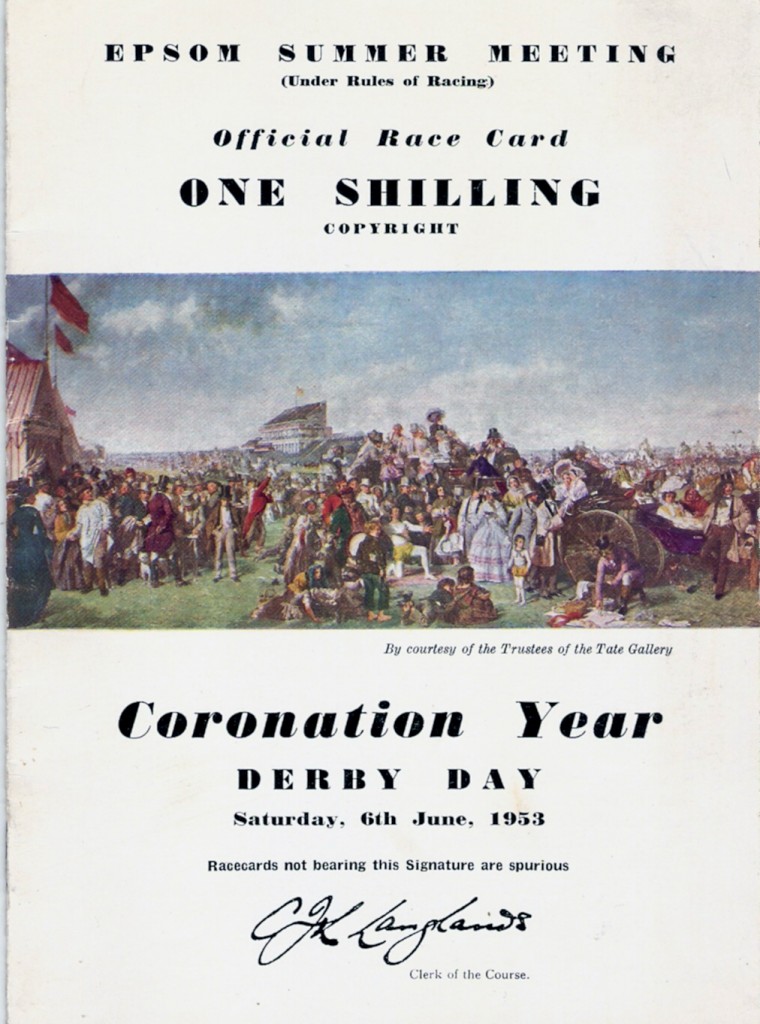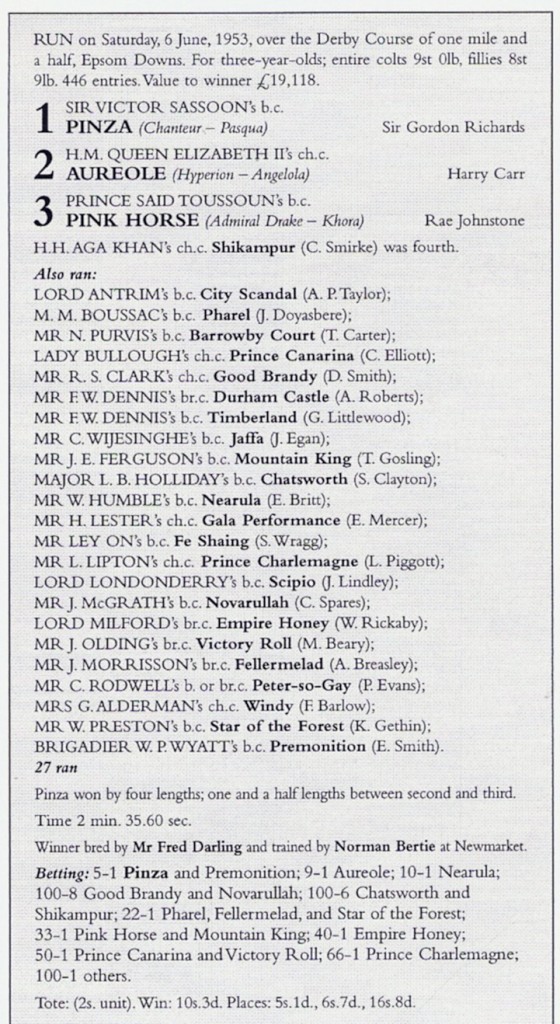Pinza and Sir Gordon Richards
As we celebrate The Queen’s 60th anniversary, I should like to recall the events of the Coronation Derby. A race in which her first Derby runner, Aureole, finished second to Pinza.
A few days before the 1953 Derby, the newly crowned Queen Elizabeth II conferred a knighthood on Gordon Richards for his services to racing. On Derby Day, Sir Gordon was to make his 28th and final attempt to win the race, this time on Pinza, a powerful bay of 16.1 hands by the French stayer Chanteur out of Pasqua, by Donatello.
Bred by Fred Darling, Pinza was sold as a yearling to Sir Victor Sassoon at the Newmarket Sales for 1,500 guineas. Sent to Newmarket trainer Norman Bertie, although backward as a two-year-old, Pinza won two of his four starts, concluding with an impressive five lengths victory in the Dewhurst Stakes.
He was allotted 9st 2lb in the Free Handicap, 5lb less than the Middle Park winner Nearula. Slow to recover from a fall on gravel in the winter, Pinza missed the Guineas and returned in mid-May to win the Newmarket Stakes in a canter. After which, his Derby price was immediately cut from 33-1 to 8-1.
 Derby Day was hot and sunny and the crowd, reported to be more than half-a-million, had been swelled by the thousands who had come to London for the Coronation earlier in the week. The Queen’s runner Aureole, having won the Lingfield Derby Trial, had been a leading fancy for some weeks, but after sweating up in the preliminaries drifted out to 9-1. Joint-favourites at 5-1 were Pinza and Aureole’s stable companion Premonition, winner of the Great Northern Stakes at York. Also in contention was the Two Thousand Guineas winner Nearula, who had missed a vital week of preparation and was now offered at 10-1.
Derby Day was hot and sunny and the crowd, reported to be more than half-a-million, had been swelled by the thousands who had come to London for the Coronation earlier in the week. The Queen’s runner Aureole, having won the Lingfield Derby Trial, had been a leading fancy for some weeks, but after sweating up in the preliminaries drifted out to 9-1. Joint-favourites at 5-1 were Pinza and Aureole’s stable companion Premonition, winner of the Great Northern Stakes at York. Also in contention was the Two Thousand Guineas winner Nearula, who had missed a vital week of preparation and was now offered at 10-1.
The 27 runners on their way, Shikampur took an early lead and coming down the hill he was four lengths clear of Victory Roll and Mountain King, with Pinza close up. Around Tattenham Corner, Richards, finding an opening on the rails, moved Pinza into second place.
Once in the straight, Charlie Smirke continued to ride out Shikampur, but Pinza closed rapidly and swept by two furlongs out. In the final stages, Aureole made steady progress on the outside, but by now it was too late and the deafening cheers from the distance told the tale – Gordon Richards had finally won the Derby.
To all those who witnessed the occasion (including the author) it was a never-to-be-forgotten day. Aureole was second, four lengths away, with Pink Horse running on in third and the gallant Shikampur fourth. After the weigh-in the Queen sent for the winning jockey to offer her congratulations.
Sir Gordon Richards (1904-1986), one of a family of 12 children, was born at Donnington Wood, near Oakengates in Shropshire, where his father was a coal miner. Gordon served his apprenticeship with Martin Hartigan at Foxhill and rode his first winner on Jimmy White’s Gay Lord at Leicester on 16 October, 1920. He was Champion Jockey for the first time in 1925 and, in 1933, made the front pages of every Daily newspaper when beating Fred Archer’s record of 146 winners in a season.
A modest, dedicated man of great integrity, Gordon Richards was the undisputed hero of those who followed racing for the first half of the 20th century, and his Derby victory on Pinza the most popular of that period.
In 1954, when leaving the paddock at Sandown, the filly Abergeldie reared up and fell over backwards on top of Richards, breaking his pevis and dislocating four ribs. The following year, fully recovered, he trained from Beckhampton, later moving first to Ogbourne-Maizey and then to Whitsbury in Hampshire, with Scobie Breasley as stable jockey.
Gordon Richards was Champion Jockey 26 times and from 21,834 mounts rode 4,870 winners. His 14 Classic winners included Tudor Minstrel (1947 Two Thousand Guineas) and Sun Chariot (1942 fillies’ Triple Crown).
Returning to Pinza, in the King George VI and Queen Elizabeth Stakes, he again beat Aureole, this time by three lengths. However, shortly afterwards, he broke down and never raced again. Syndicated at a value of £200,000, he retired to stud.
With the exception of Pinturischio, who was sensationally, twice poisoned when favourite for the 1961 Derby, Pinza never produced a horse equal to himself.
He died in 1977 and is buried at Woodditton Stud, Newmarket.
A video of Michael’s personal account of the 1953 Coronation Derby, can be found at the foot of “About Michael”.
For more racing history go to Michael’s Books for Sale
